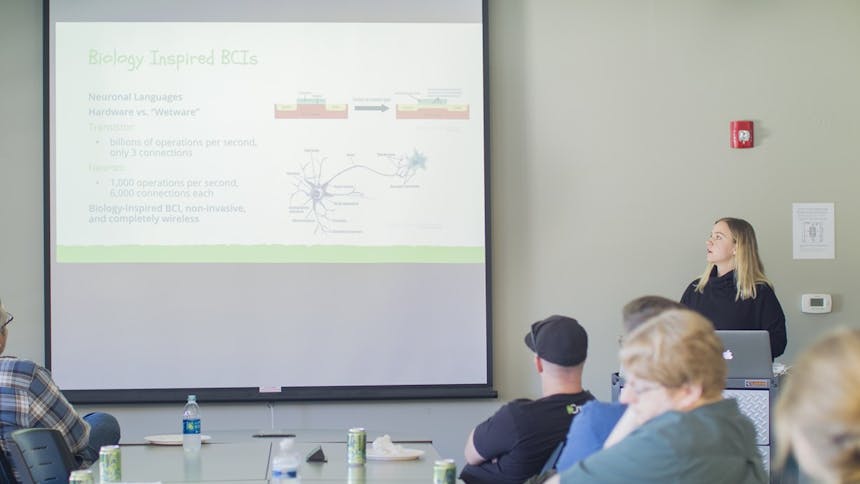
It’s 2019, and science fiction is no longer. We’re living in an age of science reality! Our March Lunch Meet (a monthly team-led learning series) tackled the topic of brain computer interfaces (BCI), which was just what our movie-minded team was craving. UX development intern Madalyn Pape delivered the impressive presentation, as the topic is a personal passion.
Avatar, The Matrix, Star Trek and Marvel’s X-Men … now these are films about mind control that we can understand! But connecting our brain to a computer in real life? As Maddy explained, this very real technology allows our brain to send direct signals to a computer, where those signals are processed and translated to commands to be carried out by the computer. The brain connection can be invasive (which is just like it sounds) or non-invasive, connected to the outside of our heads. And the results could alter the course of the world as we know it.
Take this invasive use of BCI for example. The patient in the video is controlling a robotic arm, just by thinking about it. Or this example, where two men, half a mile apart, send brain signals to each other through synthetic telepathy, made possible by non-invasive BCI, to play a video game. The future is now, people!
Fun and games aside, there are real benefits to BCI for people who are paralyzed or suffer from other debilitating nervous system issues. And in the future, one researcher believes we can use BCI combined with artificial intelligence to boost our own general brainpower.
But first, we need to get better at artificially recreating wetware – a term drawn from the computer-related idea of hardware or software but applied to biological life forms like brain cells and thought processes. You see, an artificial transistor that records neural activity can complete billions of operations per second, but only has 3 connections. A wetware neuron completes thousands of operations per second but has 6,000 connections to record chemical communications. Wetware has an added ability to send and receive signals that are chemical, visual, and thermal. We’re just not there yet, but that gives us some time to catch up to this technology’s pro’s and con’s.
Want to know more? Maddy made her complete presentation available here.
I can’t wait to see what our next brilliant team member shares at the April Lunch Meet. I am completely fascinated by this lunch series so far, and continually impressed by my learning-loving coworkers.
Until then, tinfoil on my head.
You may also be interested in...
Remember, there’s always another way. It’s the last bullet on our list of SoCreate company values, but certainly not least. The SoCreate team is made up of lifelong learners, and we constantly strive to find new, better ways of doing things. We’re baking that value into our newest office initiative: Lunch Meet. Lunch Meet is a monthly series where we meet for lunch (but not necessarily lunch meat 😊) to show and tell what we’ve recently learned in hopes that it provides value to the rest of the team. The event also gives us all a chance to get together as a group and socialize, since every team...
SoCreate Announces Launch of Angular Playground V5.2
SoCreate is thrilled to announce Angular Playground, V5.2, revamped and better than ever! Since launching the original open-source Angular Playground application in May 2017, we have improved the sandbox tool to feature an improved user interface, updated documentation, and better performance. And now, Angular Playground works with Angular 6 and Angular CLI 6. More new features include: The ability to install Angular Playground with ng (easy installation of the Angular Playground) Enabled UI overlay for access to the command bar in mobile/iPad testing A new configuration option...
